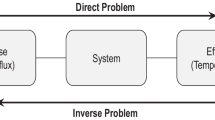Abstract
Reducing metal machining costs and harmful effects to the environment are the main benefits of dry machining compared to the application of cooling lubricants during machining processes. The abandonment of any lubricants is causing higher temperatures of workpiece, chip, and tool. Thus, the temperature gradient varies with time and space over the workpiece, causing dimensional deviations and profile defects due to thermal expansion and shrinking. The aim of this work is to determine the heat flux to the workpiece from experimental data. The temperatures of the workpiece were measured during an orthogonal turning process of carbon steel (AISI 1045). An analogous thermal model is used to solve the ill-posed inverse heat conduction problem by the sequential estimation method, introduced by Beck et al. (Inverse heat conduction, Wiley, New York, 1985) and for the evaluation of the results. The heat flux to the workpiece could be used in further work as a basic boundary condition in finite element simulations to find an alternative tool path, which compensate thermally induced deviations and profile defects of the workpiece. The heat flux to the workpiece is calculated for different cutting velocities, feed rates, and the influence of TiN-coatings on cemented carbide tools. Cutting parameters have been identified to minimize the heat load on the workpiece in general and therefore reduce errors due to dry machining.







Similar content being viewed by others
References
Klocke F, Eisenblätter G (1997) Dry cutting. CIRP Ann Manuf Technol 46(2):519–526
Weinert K, Inasaki I, Sutherland JW, Wakabayashi T (2004) Dry machining and minimum quantity lubrication. CIRP Ann Manuf Technol 53(2):511–537
Bryan J (1990) International status of thermal error research (1990). CIRP Ann Manuf Technol 39(2):645–656
Weck M, McKeown P, Bonse R, Herbst U (1995) Reduction and compensation of thermal errors in machine tools. CIRP Ann Manuf Technol 44(2):589–598
Aurich JC, Zimmermann M, Schindler S, Steinmann P (2014) Analysis of the machining accuracy when dry turning via experiments and finite element simulations. Prod Eng 8(1–2):41–50
Klocke F, Lung D, Puls H (2013) FEM-modelling of the thermal workpiece deformation in dry turning. Proced CIRP 8:240–245
Brinksmeier E, Brockhoff T (1996) Utilization of grinding heat as a new heat treatment process. CIRP Ann Manuf Technol 45(1):283–286
Deppermann M, Puls H, Burghold ME, Kneer R, Klocke F (2014) Experimental investigation of the work piece temperatures in dry orthogonal metal turning. In: Proceedings of the 15th international heat transfer conference, Begell House, Kyoto, Japan, no. 9223 in IHTC15
Heisel U, Storchak M, Krivoruchko Dmitrii (2013) Thermal effects in orthogonal cutting. Prod Eng 7(2–3):203–211
Beck JV, Blackwell B, Clair CRS (1985) Inverse heat conduction. Wiley, New York
Alifanov OM (1994) Inverse heat transfer problems, 1994. Springer, New York
Sölter J, Gulpak M (2012) Heat partitioning in dry milling of steel. CIRP Ann Manuf Technol 61:87–90
Wernsing H, Gulpak M, Büskens C, Sölter J, Brinksmeier E (2014) Enhanced method for the evaluation of the thermal impact of dry machining processes. Prod Eng 8(3):291–300
Maillet D (2014) Experimental inverse problems: potentials and limitations. In: Proceedings of the 15th international heat transfer conference, Begell House, Kyoto, Japan, no. KN10 in IHTC15
Carslaw HS, Jaeger JC (1959) Conduction of heat in solids, Second edn. Oxford University Press, Oxford
Mueller JL, Siltanen S (2012) Linear and nonlinear inverse problems with practical applications. Society for Industrial and Applied Mathematics, Philadelphia
Acknowledgments
The authors would like to thank the German Research Foundation (Deutsche Forschungsgemeinschaft, DFG) for the funding of the depicted research within the priority programme 1480 (SPP 1480). Further, the authors would like to thank Prof. Klocke and Hendrik Puls of the Laboratory for Machine Tools and Production Engineering (WZL), RWTH Aachen, for providing the turning machine and the support in performing the experiments.
Author information
Authors and Affiliations
Corresponding author
Rights and permissions
About this article
Cite this article
Deppermann, M., Kneer, R. Determination of the heat flux to the workpiece during dry turning by inverse methods. Prod. Eng. Res. Devel. 9, 465–471 (2015). https://doi.org/10.1007/s11740-015-0635-6
Received:
Accepted:
Published:
Issue Date:
DOI: https://doi.org/10.1007/s11740-015-0635-6



